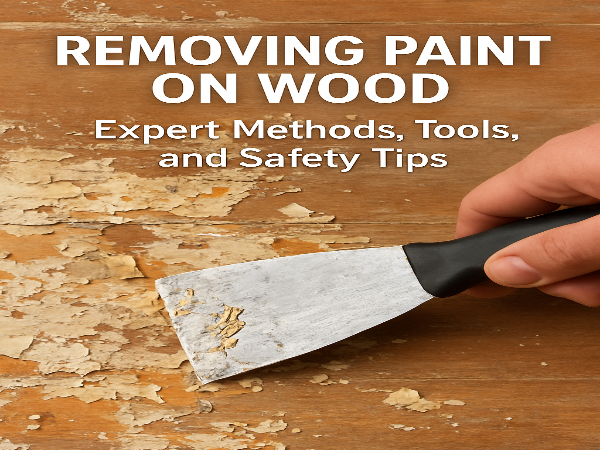Removing Paint on Wood: Expert Methods, Tools, and Safety Tips
A Complete Guide to Restoring the Natural Beauty of Wooden Surfaces

Removing paint on wood requires careful techniques to restore the material’s natural beauty without causing damage. Whether it’s an antique chair, hardwood floor, or an outdoor deck, choosing the right paint removal method—such as chemical strippers, heat guns, sanding, or scraping—ensures a smooth and clean surface ready for refinishing. By combining the right tools, safety precautions, and step-by-step processes, anyone can achieve professional-quality results and bring wooden surfaces back to life.
Introduction
Wood is one of the most timeless and beautiful materials used in furniture, flooring, and outdoor structures. Over time, many wooden surfaces get painted, sometimes to protect the material, other times to give it a new look. However, when the paint begins to peel, crack, or fade—or when you want to reveal the natural grain beneath—it becomes necessary to remove the old layers. Removing paint on wood is more than just a cosmetic process; it’s about reviving the original charm of the wood while preparing it for a new finish.
This article provides a comprehensive guide on the best methods, tools, and safety tips for removing paint on wood. Whether you are a homeowner, DIY enthusiast, or professional woodworker, this step-by-step resource will help you achieve high-quality results.
Why Remove Paint from Wood?
Before exploring the techniques, it’s important to understand why removing paint on wood is often the best choice.
Restoration of Beauty: Many antique and vintage pieces are made from high-quality wood. Stripping paint allows the grain and texture to shine again.
Preparing for Refinishing: A clean, smooth surface ensures better adhesion for stains, oils, or new paint.
Repair and Maintenance: Old paint can hide cracks, damage, or rot. Stripping it reveals the true condition of the wood.
Increased Value: For furniture, restoring natural wood can significantly enhance resale or aesthetic value.
Methods of Removing Paint on Wood
There isn’t just one way to remove paint. The best method depends on the type of wood, the number of paint layers, and the level of detail in the surface. Let’s explore the main options.
Chemical Strippers
Chemical paint strippers are designed to soften and lift layers of paint for easy removal. These products come in gels, pastes, or liquids.
Advantages:
Effective for multiple paint layers.
Works well on carvings, mouldings, and intricate designs.
Minimal scraping required.
Disadvantages:
Can release strong fumes; requires proper ventilation.
Some formulas are harsh and may damage the wood if not used carefully.
Waste disposal must be handled responsibly.
How to Use:
Apply the stripper evenly with a brush.
Cover with plastic wrap if needed to keep it active longer.
Wait for the paint to bubble and soften.
Scrape gently with a putty knife or scraper.
Neutralize the surface if required by the product.
Heat Guns and Infrared Tools
Using heat is another effective way to strip paint. Heat guns or infrared devices soften the paint, making it easy to scrape off.
Advantages:
Fast method for thick or old paint.
No harsh chemicals.
Effective on flat and curved surfaces.
Disadvantages:
Risk of scorching or burning the wood.
Hazardous if paint contains lead.
Requires practice and constant motion.
How to Use:
Set the heat gun to a low-medium setting.
Hold it a few inches from the surface, moving slowly.
As paint bubbles, scrape carefully with a tool.
Avoid concentrating heat in one area to prevent damage.
Sanding
Sanding is one of the most traditional ways to remove paint, particularly from flat wooden surfaces.
Advantages:
Leaves the surface smooth and ready for finishing.
Simple and accessible—sandpaper or electric sanders are widely available.
No chemicals involved.
Disadvantages:
Time-consuming for thick paint layers.
Creates dust, which can be harmful if old paint contains lead.
Hard to use on detailed or intricate surfaces.
How to Use:
Start with coarse grit sandpaper (e.g., 80 grit).
Gradually move to finer grits (120, then 180) for a smooth finish.
Always sand with the grain of the wood to avoid scratches.
Use detail sanders for corners and edges.
Manual Scraping
Scraping with hand tools like putty knives, chisels, or wire brushes is another method, often combined with others.
Advantages:
Low cost and accessible.
Great for small or detailed areas.
Precise control over paint removal.
Disadvantages:
Labor-intensive and time-consuming.
Can gouge or scratch the wood if too much pressure is applied.
How to Use:
Choose the right scraper for the surface.
Apply steady but gentle pressure.
Work in sections to avoid damaging the grain.
Specialized Methods
Soda blasting or media blasting: Uses fine abrasive particles to remove paint. Effective for large surfaces but must be carefully controlled to avoid damage.
Infrared paint removers: Gentle on wood and eco-friendly, but more expensive.
Step-by-Step Process for Best Results
For most projects, a combination of methods works best. Here’s a proven workflow:
Preparation
Remove hardware, hinges, and fixtures.
Clean the surface of dust, grease, or dirt.
Protect surrounding areas with drop cloths or tape.
Choose a Removal Method
For heavy paint layers: start with chemical stripper or heat gun.
For lighter coats: sanding or scraping may be enough.
Paint Removal
Work in small sections.
Scrape gently as paint softens or loosens.
Reapply stripper or heat if needed.
Detail Work
Use fine tools or brushes for grooves and carvings.
Sand edges and corners by hand.
Final Sanding and Cleaning
Sand the surface smooth with fine grit.
Remove all dust with a vacuum or tack cloth.
Finish Preparation
Repair cracks or holes with filler.
Allow the wood to dry fully before staining, sealing, or painting.
Safety Tips When Removing Paint on Wood
Test for Lead: Use a lead test kit before sanding or heating old paint.
Ventilation: Always work in a well-ventilated space.
Protective Gear: Wear gloves, goggles, and a respirator when using chemicals or sanding.
Fire Safety: Be cautious when using heat guns. Keep a fire extinguisher nearby.
Proper Disposal: Dispose of paint chips, dust, and chemicals safely.
Common Mistakes to Avoid
Leaving stripper on too long, which can damage the wood.
Overheating with a heat gun and causing scorch marks.
Using coarse sandpaper for finishing, leaving scratches.
Ignoring safety gear and risking exposure to harmful substances.
Not cleaning the surface properly before refinishing.
Best Practices for Refinishing After Paint Removal
Once the paint is gone, you’ll want to give your wood the finish it deserves:
Staining: Enhances the grain and adds warmth.
Varnishing or Sealing: Protects against moisture and wear.
Painting Again: Apply primer first for strong adhesion.
Natural Oils: Options like linseed or tung oil nourish the wood.
Conclusion
Removing paint on wood is both an art and a science. With the right tools, methods, and safety precautions, you can reveal the natural charm of wooden furniture, floors, or outdoor structures. Whether you use chemical strippers, heat, sanding, or a combination of techniques, the key is patience and attention to detail. Done correctly, the process will reward you with a smooth, clean surface that’s ready for a fresh finish—bringing new life to your cherished wooden pieces.



